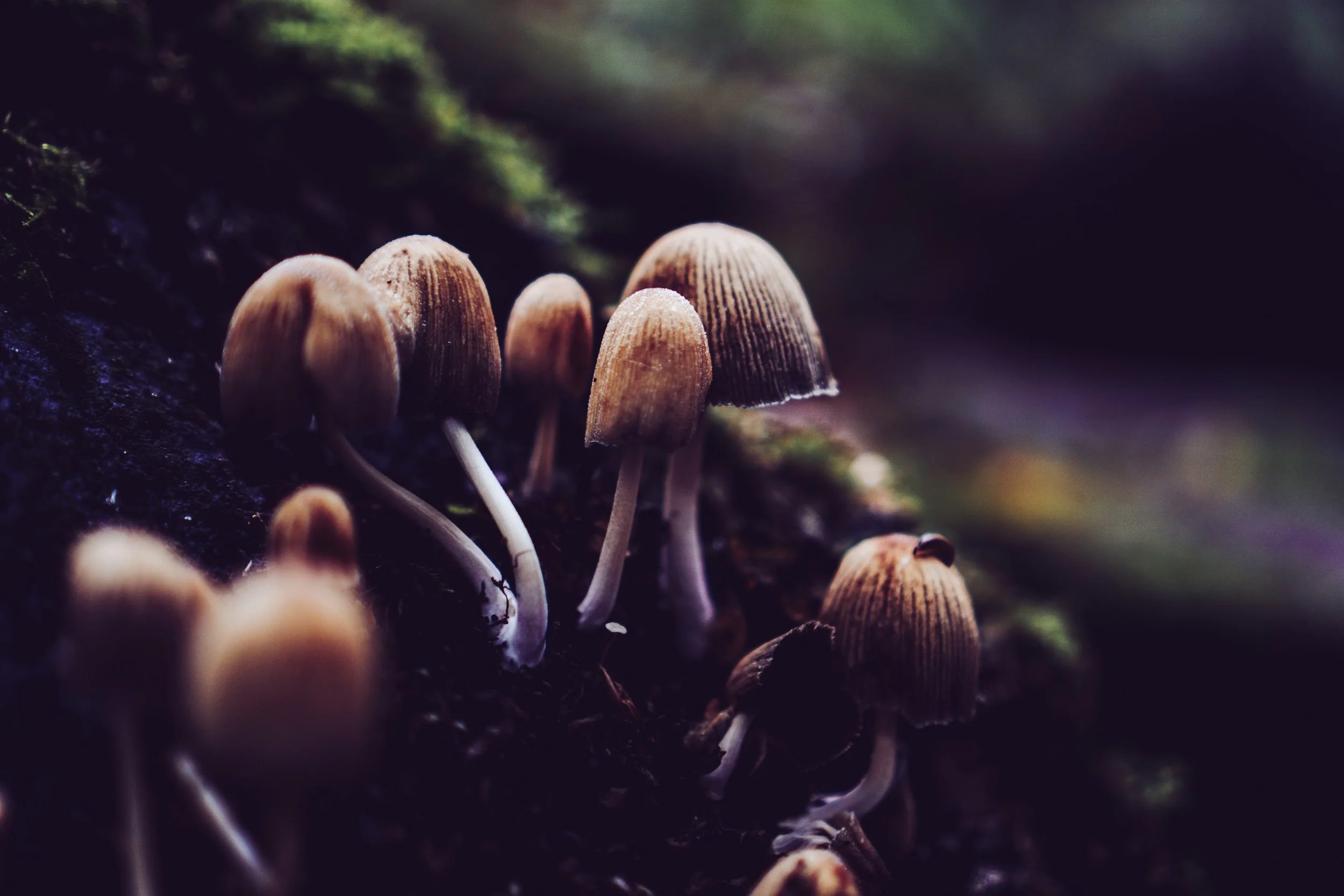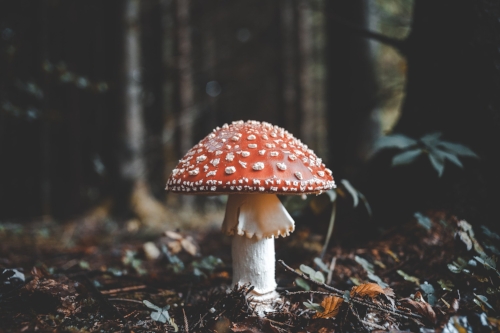Mycelium - The Future is Fungi
They were here first...
Did you know that long before trees overtook the land, earth was covered by giant mushrooms. Researchers found that land plants had evolved on Earth by about 700 million years ago and land fungi by about 1,300 million years ago. The largest living organism in the world today is a honey fungus measuring 2.4 miles (3.8 km) across in the Blue Mountains in Oregon.
So what's so special about fungi and how do they contribute to the ecosystem?
Fungi play an important role in energy cycling within, and between, ecosystems. Fungi are found in terrestrial, marine and freshwater environments, and are part of a diverse community of “decomposers” that break down dead plants and animals. Aside from fungi, this community includes bacteria, tiny invertebrates, such as nematodes, and larger invertebrates, like snails, beetles and earthworms. Fungi transform organic matter into forms that can be utilized by other decomposers, and into food for plants.
DECOMPOSITION
Fungi live everywhere that moisture is present. They can be found as single-celled organisms, like yeast, that are invisible to the naked eye, and as multiple-celled organisms, like mushrooms, that are made up of strands of cells called “hyphae.” Fungi are so widespread and numerous that they make up a large proportion of the biomass in any given ecosystem. Fungi play a very important part in the decomposition process, because they can break down tough organic materials, such as cellulose and lignin, which invertebrates find difficult to digest. Fungi release digestive enzymes that are used to metabolize complex organic compounds into soluble nutrients, such as simple sugars, nitrates and phosphates. Unlike animals, that digest food inside their bodies, fungi digest food outside of their “bodies” and then absorb the nutrients into their cells.
NUTRIENT CYCLING
Plants require nutrients for growth, but nutrients are seldom freely available in soil or water because they are locked up in insoluble compounds. Plants therefore rely on decomposers to provide them with soluble nutrients that can be taken up by roots. For instance nitrogen, one of the most important plant nutrients, is locked into proteins that are not easily taken up by plants -- although some plants have been shown to do so. Fungi metabolize proteins, and release inorganic forms of nitrogen, such as nitrate, that can easily be taken up by plant roots. In freshwater environments fungi are instrumental in the transfer of energy from riparian forest to aquatic ecosystems, by decomposing wood and leaf litter that fall into the water. In terrestrial systems, fungi transfer energy from above the ground, to below it, where it is recycled back to plants.
SYMBIOSIS
Some species of fungi form symbiotic relationships with plants. Mycorrhizal fungi are associated with plant roots. This relationship is mutually beneficial because fungi facilitate the transfer of nutrients from the soil into plant roots, and in turn receive carbon from the plant. Carbon is stored by fungi in the soil and therefore is not released as carbon dioxide. It was once thought that plants were the only source of carbon for mycorrhizal fungi. However, an article published in the May 2008 issue of “Functional Ecology” reveals that mycorrhizal fungi can actively decompose organic carbon, and therefore play a greater role in carbon loss and input from soil than previously thought. Lichens are another type of fungi that form a symbiotic relationship, but they do so with cyanobacteria. Lichens provide shelter for the bacteria, which in turn make energy and carbon for lichens via photosynthesis.
FOOD SOURCE
There are many animals that rely partially, or wholly, on fungi as a food source. Herbivorous mammals tend to be opportunistic fungus feeders, eating fungi if they come across it while browsing in the forest. However, for some animals fungi makes up a large part of their diets. Examples are the caribou, which relies heavily on tree lichens for food during the winter when leafy foods are not available, and the long-nosed potoroo, an Australian mammal whose diet consists almost entirely of fungal fruiting bodies. Many invertebrates also eat fungi, both opportunistically and actively. Stream invertebrates receive extra energy when they eat decaying leaves that have fungi growing on them. Banana slugs are commonly observed feeding on mushrooms and other fungi, which they appear to favor over other foods.
The discipline of biology devoted to the study of fungi is known as mycology. Mycelium is the vegetative part of a fungus, consisting of a network of fine white filaments (hyphae) .
The discipline of biology devoted to the study of fungi is known as mycology. Mycelium is the vegetative part of a fungus, consisting of a network of fine white filaments (hyphae) .
What is Mycelium?
The word mycelium literally means “more than one”. It is actually a plural form of the word Mycelia. The word has New Latin and Greek origins and was first coined in text in the early 1800’s, and refers to the thread-like body of a fungus. The main part of the fungus is the mycelia, which lives inside the substrate (wood, straw, grain, etc). The mushrooms that we eat are actually just a small visible part of the organism. In nature mushrooms "bloom" much like flowers do. Like flowers, mushrooms bloom during certain times of the year when the conditions are just right. To properly explain mycelium we have to get a little technical.
Mushrooms do not reproduce by seed or gather energy by photosynthesis like plants do. They reproduce by means of spores. These spores germinate to produce a mass of interwoven, single-cell wide structures known as hyphae. Hyphae are sometimes also called Shiro. Collectively, masses of hyphae are known as the mycelium.
Fungus absorbs nutrients from its environment (substrate, log, etc) through its mycelium in a two-stage process. First, the hyphae secrete enzymes into the decaying wood or other substrate. These enzymes break down biological polymers into smaller units such as monomers. The mycelium then absorbs these monomers, using a combination of facilitated diffusion and active transport.
Just like an apple on a tree the mushroom is a fruit of these reproducing fungi. In nature the chances of mushroom spores germinating and then actually producing a mushroom are quite slim. Everything has to be just right to actually produce a mushroom. They don’t just grow everywhere at random. This is why mushrooms are highly prized and hunted in the wild. In our sterile laboratory however we can produce mushrooms that are free of contaminates. Our mycologists cultivate a select species indoor where the mushroom mycelium can grow without the harsh environment nature sometimes provides.
Cultures can be taken from spores or from the mushroom tissue itself. In the process of germinating spores, many different strains are formed. All strains however are not compatible with each other. In taking a culture from the tissue of a living mushroom, the cultivator preserves the exact genetic character of that specific mushroom. This is also known as cloning. When spores are used, a single strain must be singled out from the vast array of strains created. In both cases, the end result is basically a network of cells. This is the amazing mycelium, the actual organism that produces mushrooms.
Stop, observe and learn from mother nature, for she has an answer to everything.
Fungi As A Building Material:
Manufactured Wood Made Without Trees:
Plastic Eating Fungi
These examples are just a tip of the iceberg. Is the future a bio-based material world? We really hope so!
Article: Elizabeth Plokker
Sources:
https://en.wikipedia.org/wiki/Mycelium
http://www.bbc.com/earth/story/20141114-the-biggest-organism-in-the-world
https://sciencing.com/fungi-contribute-ecosystem-21989.html
http://www.rainforestconservation.org/rainforest-primer/rainforest-primer-table-of-contents/g-rainforest-ecology/10-roles-of-fungi-and-other-microbes/
http://science.psu.edu/news-and-events/2001-news/Hedges8-2001.htm
https://www.nature.com/articles/s41559-017-0141






You don’t have to go to Artis to see spectacular animals in Amsterdam! The City’s wildlife is unfolding right in front of your doorstep. All you need to have is patience, some luck, and awareness. Amsterdam counts over 10 000 wild plants and animal species that bring this city to life.